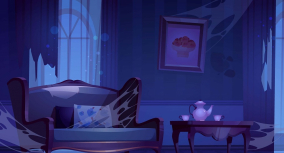“The Yellow Wallpaper” themes include gender roles, mental illness, and freedom. These motifs are interconnected in that they’re all tied to the harsh treatment of mentally struggling women in the 19th century. Back then, the “rest cure” was especially popular. The story vividly portrays the consequences of such therapy, which often left patients even more psychologically unstable.
This article by Custom-Writing.org experts will explain the themes of “The Yellow Wallpaper” in-depth. Here, you will find answers to questions such as:
- Why is the identity theme in the story closely connected with freedom?
- What concepts and ideas does Gilman make particularly prominent?
- What statement does “The Yellow Wallpaper” make through its themes?

🌟 The Yellow Wallpaper Themes List
The main themes discussed in the short story are:
- Freedom, identity, and self-expression.
- Gender roles and feminism.
- Mental illness and its treatment.
Below, we’ll discuss them in more detail.
🕊️ The Yellow Wallpaper Themes: Freedom & Identity
Freedom and identity is probably the most important The Yellow Wallpaper’s theme. In the story, John, the husband, puts restrictions on the narrator’s freedom to make her feel better. However, this has the reverse effect, although the physical limitations hurt her less than the emotional ones.
She is unable to share her worries with anyone and has to pretend that everything is alright. It even seems as though she is getting better at some point. However, we know that it is not enough of a victory in a battle against depression.
The worst part of this so-called “rest cure” is that the narrator is restrained from any mental activity. However, she understands the benefits she receives from writing, so her journal is her salvation.
By the end of the story, the reader understands the irony of this treatment. It is not her imagination that drives her mad, but the constant muzzling of her self-expression. John believes that she needs to control it. Otherwise, it would get out of hand.
In this way, Gilman shows that there is nothing worse than trapping a mind in a cage of inactivity. This containment leads the main character to lose her identity. She is stuck in a loop, where she can increasingly no longer recognize herself. This inner conflict finally emerges at the end of the story.
The Yellow Wallpaper: Quotes on Freedom
I think sometimes that if I were only well enough to write a little it would relieve the press of ideas and rest me. But I find I get pretty tired when I try. It is so discouraging not to have any advice and companionship about my work.
The Yellow Wallpaper, Narrator
I don’t know why I should write this. I don’t want to. I don’t feel able. And I know John would think it absurd. But I must say what I feel and think in some way—it is such a relief!
The Yellow Wallpaper, Narrator
I don’t like to look out of the windows even—there are so many of those creeping women, and they creep so fast. I wonder if they all come out of that wallpaper as I did?But I am securely fastened now by my well-hidden rope—you don’t get me out in the road there!
The Yellow Wallpaper, Narrator
🚻 The Yellow Wallpaper Theme: Gender Roles
One of the main themes in “The Yellow Wallpaper” is gender roles. In the nineteenth century, these roles were very well established. However, the author expresses her disagreement with them.
Gilman was an active contributor to feminism at the time, and her works on the role of women were quite famous.
John is portrayed as a typical head of the family. His decisions cannot be challenged. He treats his wife as a child and does not think her requests and wishes are valid.
However, we cannot label him as the clear antagonist in this story. John tends to act with the best of intentions. One can notice that in his reaction at the end of the narrative. Moreover, these strict, traditional rules have also affected him negatively. He can do nothing but follow them and watch his family relationships being destroyed.
The narrator obeys her dominant husband, staying at home and not working. Yet, the diary symbolizes her rebellion against him. In some way, she feels trapped in this family routine and the woman’s role that she identifies with the shadow on the wallpaper. Finally, she suffers a breakdown.
We might conclude that the whole story bases on the belief that women are forced into their homemakers’ domestic roles. Moreover, the writer might even point out the patriarchy as the reason for all the family issues.
The Yellow Wallpaper: Quotes on Gender Roles
John laughs at me, of course, but one expects that in marriage.
The Yellow Wallpaper, Narrator
And dear John gathered me up in his arms, and just carried me upstairs and laid me on the bed, and sat by me and read to me till it tired my head. He said I was his darling and his comfort and all he had, and that I must take care of myself for his sake, and keep well.
The Yellow Wallpaper, Narrator
“Bless her little heart!” said he with a big hug; “she shall be as sick as she pleases! But now let’s improve the shining hours by going to sleep, and talk about it in the morning!”
The Yellow Wallpaper, John
🤯 Theme of The Yellow Wallpaper: Mental Illness
Mental disorder is another exciting The Yellow Wallpaper’s theme. The story offers an exciting perspective on how mental illness used to be treated in the nineteenth century, specifically the “rest cure” that John uses, which ultimately fails.
Gilman’s life story is connected to the experiences of the main characters. Like the narrator, she suffered from postpartum depression. She also had to keep up with the same routine. The enforced abstinence from writing drove her mad.
John’s perspective is purely practical. Anything that could threaten his wife’s well-being should be prohibited. Thus, she is not allowed any activity that might overwhelm her or contribute to her anxiety and exhaustion. This means no guests, no writing, and no free will.
Altogether, the restrictions make the narrator feel trapped and powerless. She has no one to talk to about her concerns. John ignores them as much as possible. It makes the reader rethink the methods used in treatments at the time. Such vulnerable patients as the narrator would require more human contact and a personalized approach for a successful recovery.
Therefore, the story might be a representation of how mental disorders are neglected and undermined in society. Even nowadays, some women’s complaints about their mental health are counted as mere moodiness.
The Yellow Wallpaper: Quotes on Mental Illness
But these nervous troubles are dreadfully depressing. John does not know how much I really suffer. He knows there is no reason to suffer, and that satisfies him. Of course it is only nervousness. It does weigh on me so not to do my duty in any way!
The Yellow Wallpaper, Narrator
I’m feeling ever so much better! I don’t sleep much at night, for it is so interesting to watch developments; but I sleep a good deal in the daytime. In the daytime it is tiresome and perplexing.
The Yellow Wallpaper, Narrator
And I heard him ask Jennie a lot of professional questions about me. She had a very good report to give. She said I slept a good deal in the daytime. John knows I don’t sleep very well at night, for all I’m so quiet! He asked me all sorts of questions, too, and pretended to be very loving and kind. As if I couldn’t see through him!
The Yellow Wallpaper, Narrator
We hope that the above information is useful. If you want to be fully aware of the true meaning of the story, you should check out both “The Yellow Wallpaper” summary and analysis. And if you’re looking for exciting essay ideas on the story, feel free to chose any of our “The Yellow Wallpaper” topics.
🔗 References
- On “The Yellow Wallpaper” – UMBC
- Gothic and the Female Voice: Examining Charlotte Perkins Gilman’s “The Yellow Wallpaper”
- “The Yellow Wallpaper” and Women’s Pain | JSTOR Daily
- Understanding The Yellow Wallpaper: Summary and Analysis
- “She Shall Be Sick As She Pleases”: Madness and Identity in The Yellow Wallpaper and The Haunting of Hill House
- Feminist Criticism, “The Yellow Wallpaper,” – JStor











